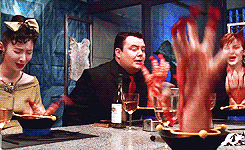3 Alien-ish Creatures on Earth 👽
Our obsession with the universe has taught us many things, but the one thing that stands out is—that earth is as mysterious as the farthest reaches of space.
Certain earth-bound plants, animals, and rocks fall under an alien-like category, and although the thought of stepping out onto an alien planet might sound like a thrilling book or movie you'll consume this weekend, it's real life.
So, we wanted to share a few off-planet creatures that had us wondering: Just how much alien life exists on earth?
#1. The Nightmarish Devil’s Finger Fungus
When other plants and flowers became the best smelling thing in the forest to attract pollinators, the Devil's Finger Fungus created a league of their own—a putrid stench to attract insects and critters that love the smell of rotting flesh.
Where can you find such an eerie mushroom? Imagine leisurely hiking through Australia along the Bibbulmun Track or in New Zealand along the Te Araroa—and BAM—you stumble on a very stinky mushroom that looks like an upside-down octopus. After that, you might never go on a walkabout again.
Image Credit: Wikipedia
The strange eight-tentacle mushroom is called the Devil’s Finger Fungus (also known as the Octopus Fungus or stinkhorn) and was first discovered in Britain in 1914.
It's about eight inches in length (20 centimeters) and 4 inches in height (10 centimeters). That's about the size of a piece of legal paper folded in half. So the Octopus Fungus is s a giant mushroom.
The stinkhorn hatches from a sack that looks like a dinosaur egg, and, once birthed, it untangles four to eight bright red tentacles with sticky black barbs.
Once it emerges from its oatmeal-colored sack, the stinkhorn spews toxic-smelling slime everywhere, like a mini volcano. The goo unleashes thousands of fungus babies (also known as spores) that get carried away to neighboring grass, decaying leaves, dead tree stumps, or anywhere else it can latch on. It accomplishes this through a strange relationship with flies.
Flies are attracted to the stench, and so they land on the stinkhorn and lick up the oozing gelatinous puss, like food. Then the tiny winged creatures carry away the sticky spores on their little and hairy legs, and the mushroom begins its cycle again—from hatching to spawning.
To our team, the Devil’s Finger Fungus looks a lot like the famous scene from the movie Beetlejuice (speculated to be named after the Betelgeuse star constellation) when the shrimp cocktail comes alive and attacks the dinner guests.
But whatever this alien-like mushroom reminds you of, you'll never forget seeing it for the first time.
EXTREMOPHILES
〰️
EXTREMOPHILES 〰️
#2. The Famous Tradigrade
Image Credit: National Geographic
The Tardigrade is among the cutest and clumsiest of all alien-ish creatures (also known as the water bear or moss piglet). It looks like an itty bitty pig mixed with a caterpillar because of its eight legs shaped like tiny and short gumdrops.
Don't be fooled by their cute stature or adorable snot. Water bears are extremophiles and can survive extremely hot, cold, and dry climates.
If you wanted to find a water bear, you wouldn't have to go far. While out in nature, if you touched some moss, the water droplets coating your fingers would have many tiny surprises—hundreds of tardigrades.
Water bears live primarily in water (fresh or saltwater). So they love hanging out in dewdrops, droplets under leaves in the forest, inside barnacles, or patches of moss. Since they are defenseless, moss piglets like to stay in one spot and wet.
Image Credit: BOB GOLDSTEIN
Moss piglets have coelomocyte-type cells that move freely throughout their body like pearls in a tub of water. When they dry out, they go through cryptobiosis and loss 97% of the water in their body and can come back to life when rehydrated.
Tardigrades reanimate using unique proteins like packing peanuts that protect their vital organs. So after they "die," tardigrade's little bodies "fix" the damage without aging, even if they were gone for a decade.
Water bears have a hydrostatic skeleton (no bones), which means the pressure of fluids keeps their shape. In addition, water bears have a three-headed vesicle at the top of their mouth containing thiobacteria (sulfur-based bacteria).
These sulfur-loving organisms, both in the deep-sea vents and elsewhere, include bacteria that eat hydrogen sulfide to produce fuel for their host.
Like most alien-like creatures that boggle the mind, scientists wanted to put the tiny tardigrade through the wringer. So, researchers blasted water bears with radiation that would kill one hundred people on impact, and they survived. Also, moss piglets were placed in the coldest and hottest places and thrived. They were even tossed out into the vacuum of space and became the first miniature astronauts to not only survive but also mated when they returned home to earth!
So, although tardigrades seem delicate and cute, they're amongst the strongest champions of space exploration and science.
#3. The 👽 Giant Tubeworm
Deeper than where sunlight can penetrate, an alien creature uses bacteria to support its 300 hundred to 1,000 or more year life span.
Researchers first discovered the giant tubeworm on a deep-sea mission in 1977 aboard a rover called Alvin. They launched 250 miles off the coast of the Galápagos Islands and dove more than a mile deep (or two and a half kilometers) into extremely dark and hot water near hydrogen sulfide vents.
The abundant sea life took everyone by surprise—it looked like an underwater rainforest—but what stole their attention was the forest of giant tubeworms.
Image Credit: Wikipedia
Image credit: Dive and Discover
About six feet in height, the worms' bodies are encased in a bright white hard shell made of chitin—it's the same stuff that makes the shells of crustaceans like clams and lobsters.
A dark red plume is at the end of their skinny vase-like bodies and looks like a giant red tulip. It gets its color from the blood circulating through the worm's body.
After the mission, the researchers plucked a few worms from their underwater home and sent the bodies to Meredith Jones at the Smithsonian, a worm curator. He called these alien-like creatures "Riftia pachyptila" and discovered they shouldn't even be alive because they have no mouth, anus, or stomach.
Stumped, Jones dissected the worms and found they had a trophosome and was half their body, but wasn’t like a gut at all. The worm's midsection is packed with millions of pure sulfide crystals.
Colleen Cavanaugh: Dancing in the Dark YouTube
Still confused by how the crystals tied in with how the worm performed essential life functions, Jones gave a talk at Harvard University. Luckily a brilliant student, Colleen Cavanaugh, was in the audience, and she was obsessed with extremophiles and bizarre underwater life.
Immediately, Cavanaugh knew that these worms had something inside them that was unlike anything discovered before. After Jone’s speech, Cavanaugh pulled him aside and gave her hypothesis: The giant worms are full of symbiotic bacteria that perform essential life support.
Jones dismissed Cavanaugh, who quickly didn't give up. After running several tests on the giant tubeworms, Cavanaugh discovered that she was correct—the worms were full of sulfur-eating bacteria.
Most surface plants use sunlight as fuel in a process called photosynthesis. But the giant tubeworms use chemosynthesis to transform chemicals into energy to sustain life.
The sulfide-eating bacteria get absorbed through the worm's skin, making it possible for the worm to "breath in" the hydrogen sulfide chemical near the vents, like lungs, and use it as energy (like food). Basically, the bacteria eat the hydrogen sulfide and "burp" out sulfur.
Cavanaugh's discovery became the basis of entire underwater ecosystems near or around sulfur-producing vents. And the giant aquatic worms are speculated to have been the first creatures on earth.
So, these three creatures can be proof we live on an alien-rich planet 👽.










